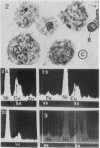Abstract
A comparative study of the elemental content of normal and leukemic cells was undertaken on a few subjects, using electron microscopic x-ray microanalysis. Phosphorus, sulfur, chlorine, calcium, copper, and zinc were detected in intracellular loci. The concentration of some of the above elements appeared to be disease related. In leukemic lymphocytes, the nuclear zinc was significantly lower than that recorded in normal lymphocytes, while the phosphorus was only moderately decreased. This suggests a faulty zinc uptake or binding in leukemic cells. The possible consequences of intracellular zinc deficiency are discussed.
Full text
PDF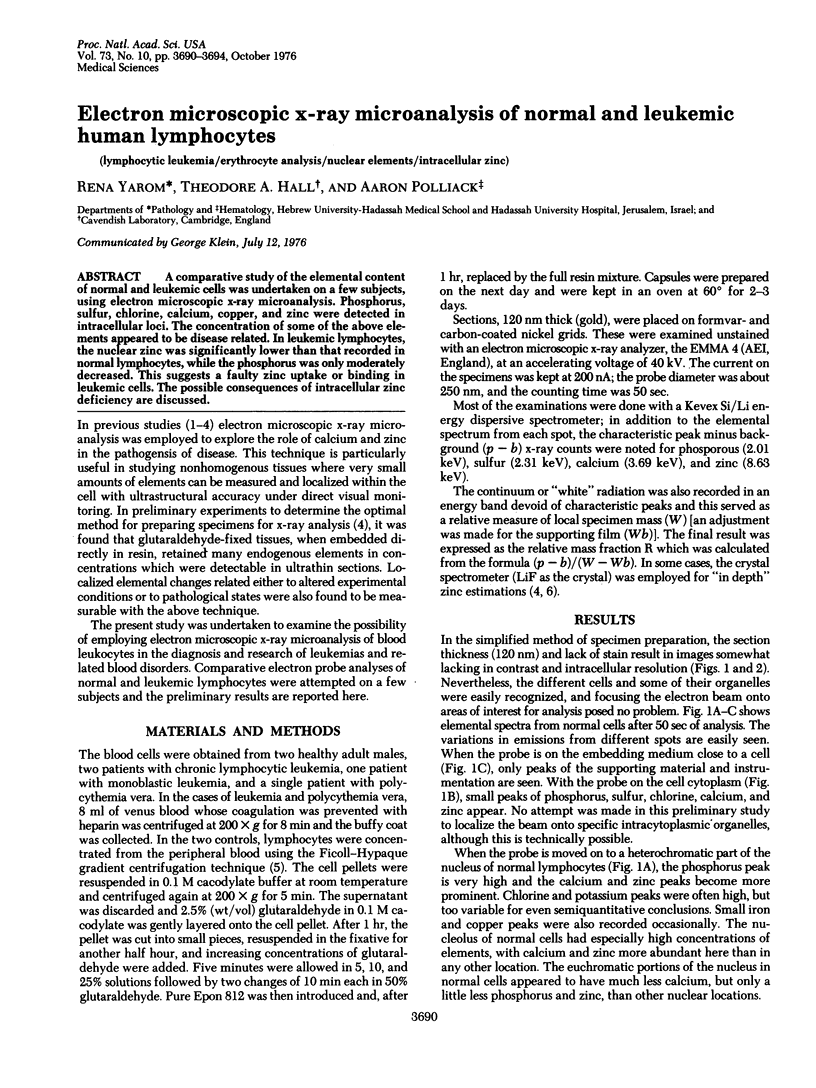
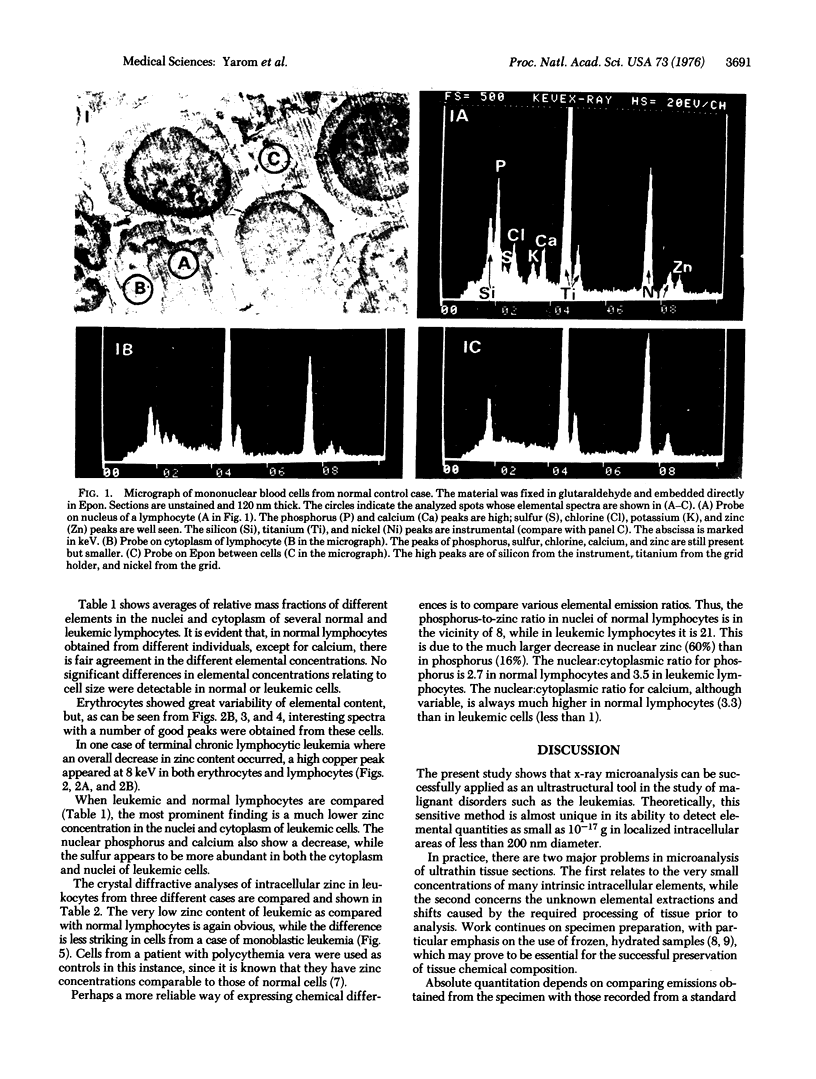
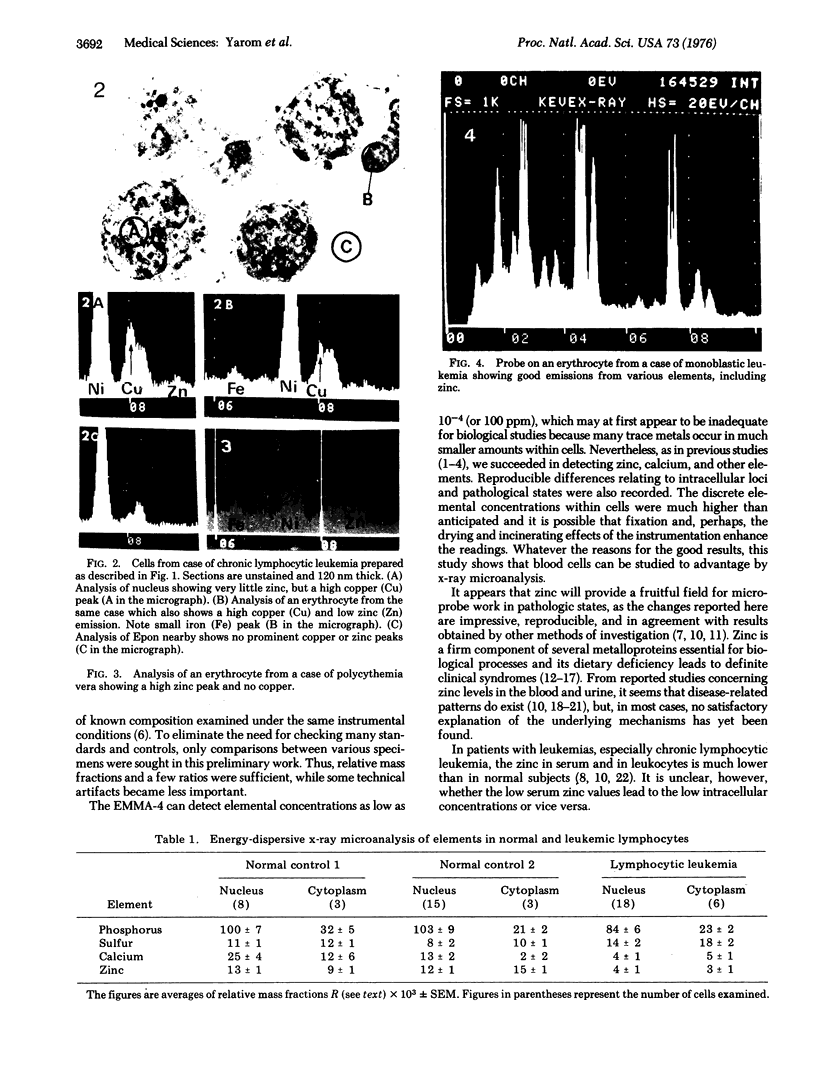
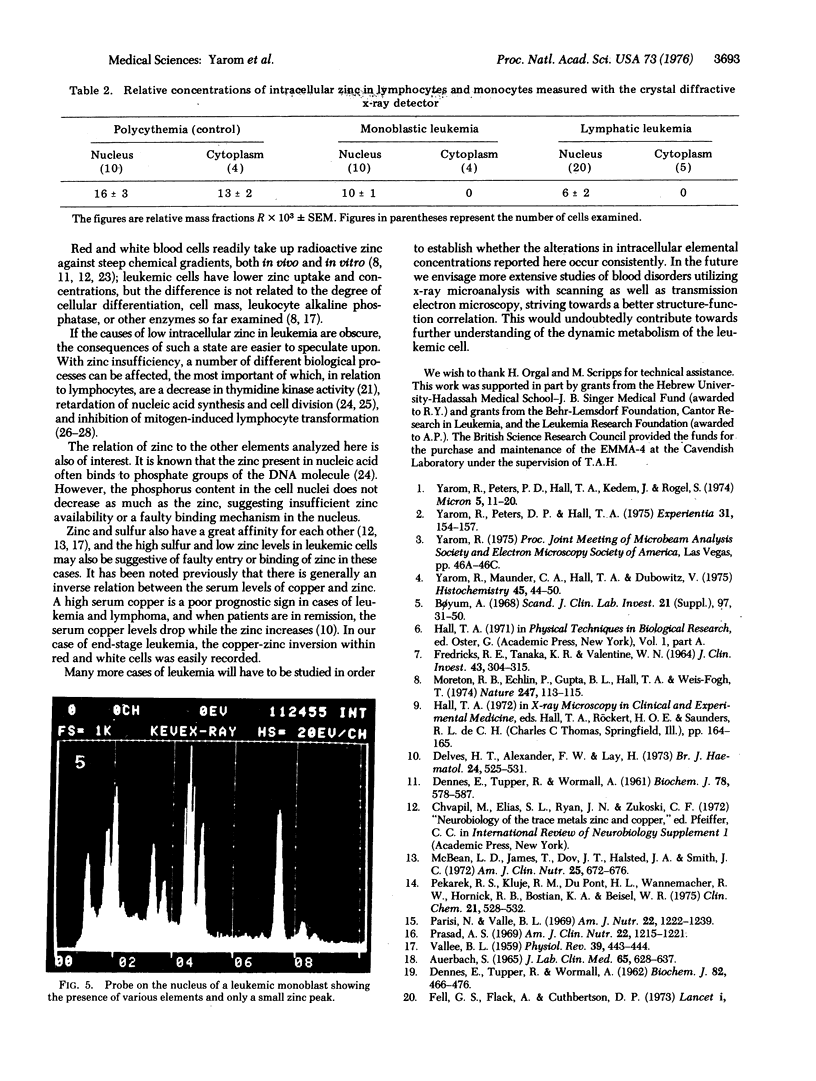
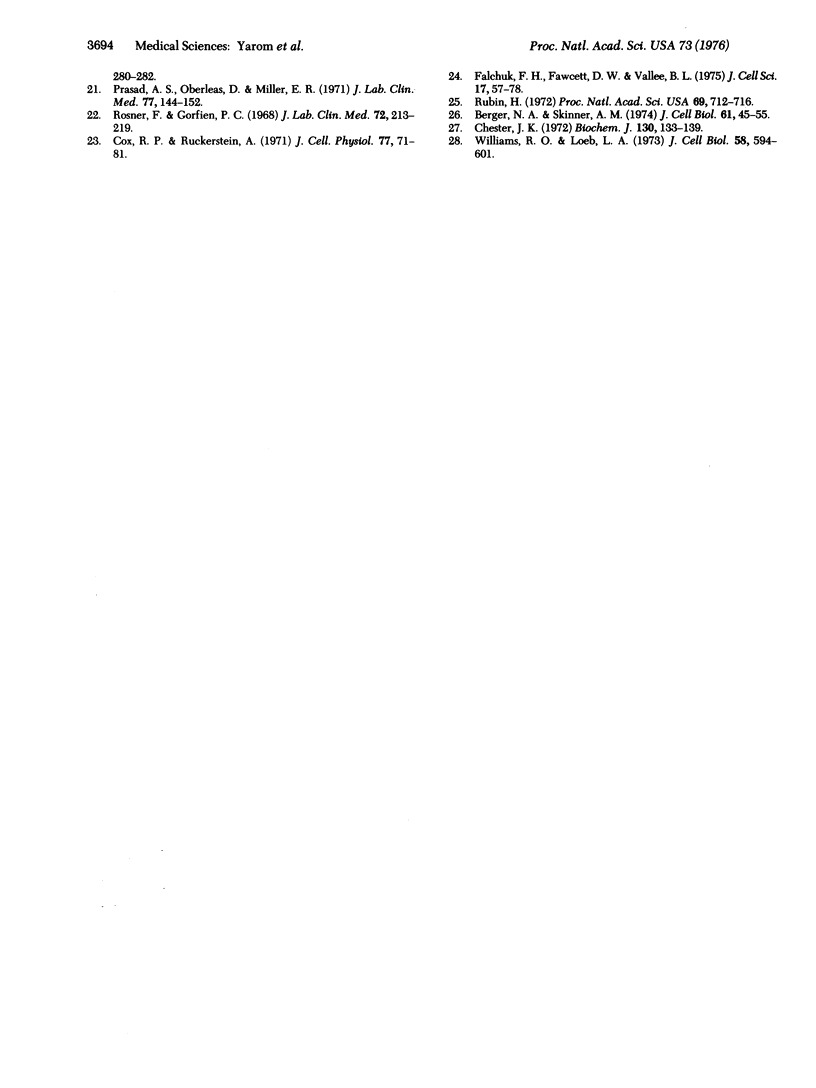
Images in this article
Selected References
These references are in PubMed. This may not be the complete list of references from this article.
- AUERBACH S. ZINC CONTENT OF PLASMA, BLOOD, AND ERYTHROCYTES IN NORMAL SUBJECTS AND IN PATIENTS WITH HODGKIN'S DISEASE AND VARIOUS HEMATOLOGIC DISORDERS. J Lab Clin Med. 1965 Apr;65:628–637. [PubMed] [Google Scholar]
- Berger N. A., Skinner A. M. Characterization of lymphocyte transformation induced by zinc ions. J Cell Biol. 1974 Apr;61(1):45–55. doi: 10.1083/jcb.61.1.45. [DOI] [PMC free article] [PubMed] [Google Scholar]
- Böyum A. Isolation of leucocytes from human blood. Further observations. Methylcellulose, dextran, and ficoll as erythrocyteaggregating agents. Scand J Clin Lab Invest Suppl. 1968;97:31–50. [PubMed] [Google Scholar]
- Chesters J. K. The role of zinc ions in the transformation of lymphocytes by phytohaemagglutinin. Biochem J. 1972 Nov;130(1):133–139. doi: 10.1042/bj1300133. [DOI] [PMC free article] [PubMed] [Google Scholar]
- Cox R. P., Ruckenstein A. Studies on the mechanism of hrmonal stimulation of zinc uptake in human cell cultures: hormone-cell interactions and characteristics of zinc accumulation. J Cell Physiol. 1971 Feb;77(1):71–81. doi: 10.1002/jcp.1040770109. [DOI] [PubMed] [Google Scholar]
- DENNES E., TUPPER R., WORMALL A. Studies on zinc in blood. Transport of zinc and incorporation of zinc in leucocytes. Biochem J. 1962 Mar;82:466–476. doi: 10.1042/bj0820466. [DOI] [PMC free article] [PubMed] [Google Scholar]
- DENNES E., TUPPER R., WORMALL A. The zinc content of erythrocytes and leucocytes of blood from normal and leukaemic subjects. Biochem J. 1961 Mar;78:578–587. doi: 10.1042/bj0780578. [DOI] [PMC free article] [PubMed] [Google Scholar]
- Delves H. T., Alexander F. W., Lay H. Copper and zinc concentration in the plasma of leukaemic children. Br J Haematol. 1973 Apr;24(4):525–531. doi: 10.1111/j.1365-2141.1973.tb01678.x. [DOI] [PubMed] [Google Scholar]
- FREDRICKS R. E., TANAKA K. R., VALENTINE W. N. VARIATIONS OF HUMAN BLOOD CELL ZINC IN DISEASE. J Clin Invest. 1964 Feb;43:304–315. doi: 10.1172/JCI104915. [DOI] [PMC free article] [PubMed] [Google Scholar]
- Falchuk K. H., Fawcett D. W., Vallee B. L. Role of zinc in cell division of Euglena gracilis. J Cell Sci. 1975 Jan;17(1):57–78. doi: 10.1242/jcs.17.1.57. [DOI] [PubMed] [Google Scholar]
- McBean L. D., Dove J. T., Halsted J. A., Smith J. C., Jr Zinc concentration in human tissues. Am J Clin Nutr. 1972 Jul;25(7):672–676. doi: 10.1093/ajcn/25.7.672. [DOI] [PubMed] [Google Scholar]
- Moreton R. B., Echlin P., Gupta B. L., Hall T. A., Weis-Fogh T. Preparation of frozen hydrated tissue sections for x-ray microanalysis in the scanning electron microscope. Nature. 1974 Jan 11;247(5436):113–115. doi: 10.1038/247113a0. [DOI] [PubMed] [Google Scholar]
- Parisi A. F., Vallee B. L. Zinc metalloenzymes: characteristics and significance in biology and medicine. Am J Clin Nutr. 1969 Sep;22(9):1222–1239. doi: 10.1093/ajcn/22.9.1222. [DOI] [PubMed] [Google Scholar]
- Pekarek R. S., Kluge R. M., DuPont H. L., Wannemacher R. W., Jr, Hornick R. B., Bostian K. A., Beisel W. R. Serum zinc, iron, and copper concentrations during typhoid fever in man: effect of chloramphenicol therapy. Clin Chem. 1975 Apr;21(4):528–532. [PubMed] [Google Scholar]
- Prasad A. S. A century of research on the metabolic role of zinc. Am J Clin Nutr. 1969 Sep;22(9):1215–1221. doi: 10.1093/ajcn/22.9.1215. [DOI] [PubMed] [Google Scholar]
- Prasad A. S., Oberleas D., Miller E. R., Luecke R. W. Biochemical effects of zinc difficiency: changes in activities of zinc-dependent enzymes and ribonucleic acid and deoxyribonucleic acid content of tissues. J Lab Clin Med. 1971 Jan;77(1):144–152. [PubMed] [Google Scholar]
- Rosner F., Gorfien P. C. Erythrocyte and plasma zinc and magnesium levels in health and disease. J Lab Clin Med. 1968 Aug;72(2):213–219. [PubMed] [Google Scholar]
- Rubin H. Inhibition of DNA synthesis in animal cells by ethylene diamine tetraacetate, and its reversal by zinc. Proc Natl Acad Sci U S A. 1972 Mar;69(3):712–716. doi: 10.1073/pnas.69.3.712. [DOI] [PMC free article] [PubMed] [Google Scholar]
- VALLEE B. L. Biochemistry, physiology and pathology of zinc. Physiol Rev. 1959 Jul;39(3):443–490. doi: 10.1152/physrev.1959.39.3.443. [DOI] [PubMed] [Google Scholar]
- Williams R. O., Loeb L. A. Zinc requirement for DNA replication in stimulated human lymphocytes. J Cell Biol. 1973 Sep;58(3):594–601. doi: 10.1083/jcb.58.3.594. [DOI] [PMC free article] [PubMed] [Google Scholar]
- Yarom R., Hall T. A., Peters P. D. Calcium in myonuclei: electron microprobe X-ray analysis. Experientia. 1975 Feb 15;31(2):154–157. doi: 10.1007/BF01990677. [DOI] [PubMed] [Google Scholar]





